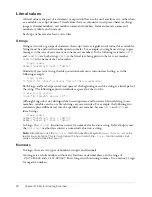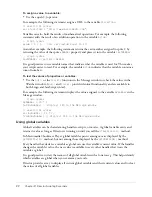
10
Chapter 2: Director Scripting Essentials
•
Parent scripts are special scripts that contain Lingo that is used to create child objects. You can
use parent scripts to generate script objects that behave and respond similarly yet can still
operate independently of each other. A parent script icon appears in the lower right corner of
the Cast window thumbnail.
For information on using parent scripts and child objects, see
“Object-oriented programming
with Lingo” on page 55
.
JavaScript syntax does not use parent scripts or child objects; it uses regular JavaScript syntax-
style object-oriented programming techniques. For information on object-oriented
programming in JavaScript syntax, see
“Object-oriented programming with JavaScript syntax”
on page 65
•
Scripts attached to cast members are attached directly to a cast member, independent of the
Score. Whenever the cast member is assigned to a sprite, the cast member’s script is available.
Unlike behaviors, movie scripts, and parent scripts, cast member scripts do not appear in the
Cast window. However, if Show Cast Member Script Icons is selected in the Cast Window
Preferences dialog box, cast members that have a script attached display a small script icon in
the lower left corner of their thumbnails in the Cast window.
Scripting terminology
Both Lingo and JavaScript syntax use some terms that are specific to each language, in addition to
some terms that are shared between each language.
Important scripting terms are listed here in alphabetical order. These terms are used throughout
the
Director Scripting Reference
, so it will help to understand these terms before moving forward.
•
Constants are elements whose values do not change. For example, in Lingo, constants such as
TAB
,
EMPTY
, and
RETURN
always have the same values, and cannot be modified. In JavaScript
syntax, constants such as
Math.PI
and
Number.MAX_VALUE
always have the same values, and
cannot be modified. You can also create your own custom constants in JavaScript syntax by
using the keyword
const
.
For more information on constants, see
“Constants” on page 20
.
•
Events are actions that occur while a movie is playing. Events occur when a movie stops, a
sprite starts, the playhead enters a frame, the user types at the keyboard, and so on. All events
in Director are predefined, and always have the same meaning.
For more information on events, see
“Events” on page 33
.
•
Expressions are any part of a statement that produces a value. For example,
2 + 2
is
an expression.
•
Functions refer to either top-level functions or specific types of JavaScript syntax code.
A top-level function instructs a movie to do something while the movie is playing or returns a
value, but it is not called from any specific object. For example, you would call the top-level
list()
function by using the syntax
list()
. Like a function, a method also instructs a movie
to do something while the movie is playing or returns a value, but it is always called from
an object.
A function is used in JavaScript syntax to represent an event handler, a custom object, a custom
method, and so on. The use of JavaScript functions in these cases is described in the applicable
topics later in this reference.
Summary of Contents for DIRECTOR MX 2004-DIRECTOR SCRIPTING
Page 1: ...DIRECTOR MX 2004 Director Scripting Reference...
Page 48: ...48 Chapter 2 Director Scripting Essentials...
Page 100: ...100 Chapter 4 Debugging Scripts in Director...
Page 118: ...118 Chapter 5 Director Core Objects...
Page 594: ...594 Chapter 12 Methods...
Page 684: ...684 Chapter 14 Properties See also DVD...
Page 702: ...702 Chapter 14 Properties See also face vertices vertices flat...
Page 856: ...856 Chapter 14 Properties JavaScript syntax sprite 15 member member 3 4...
Page 1102: ...1102 Chapter 14 Properties...

























